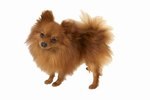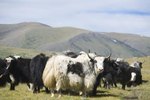
Alpacas resemble llamas, but they serve a different purpose. Llamas originally were bred to help with chores, but alpacas are raised for their fleece. Breeders raise alpacas in a similar fashion to sheep. Two distinct alpaca breeds exist, distinguished mostly by the type of fleece they provide.
Two Breeds
Alpacas might be Suri or Huacaya breeds, with Huacaya being by far the most prevalent—about 90 percent of the alpacas in the United States and up to 98 percent worldwide are Huacaya. Both breeds are about the same size and live in the same environments. Farmers shear alpacas of both breeds once a year, typically during the spring. The fleece, also called the alpaca's fiber, can be used like sheep's wool: it can be spun into yarn or woven into fabric.
Coat Texture
The main difference between the Suri and Huacaya breeds is the type of fleece they grow. Huacaya fleece looks soft and fluffy. It grows straight out from the body in tightly crimped curls that intertwine, providing exceptional cold-weather protection. The fleece is soft and fine. Suri alpacas have longer fleece that grows downward in curled locks that look almost like a curtain, and has a smoother feel than Huacaya fleece. Suris often looks smaller than Huacayas because their fleece doesn't fluff out; however, the alpacas are the same size under all that fiber.
Coat Color
Alpacas of both breeds share several color similarities, with a few differences. Both provide fleece in black, tan, brown and white. Huacaya fleece also grows in several shades of gray, while Suris typically don't provide that color. However, Suri fleece might include Appaloosa markings, which means large spots of a different color, such as white fleece with large black areas. Huacayas usually don't sport Appaloosa markings. Both types of fleece take dye well, allowing you to change the color, within reason; it's difficult to make dark fleece lighter, for example, but white and light-gray fleece might work with a variety of dyes.
Fleece Uses
Because the two breeds have different fleece textures, the fiber is used slightly differently. Both types are softer than sheep wool, making them ideal for clothing that touches the skin. Huacaya fleece, especially, is used for clothes such as socks, mittens and sweaters. Suri fleece has more luster and feels a bit more slippery, making it ideal for high-quality outerwear such as coats and shawls.
References
Photo Credits
-
Jupiterimages/Photos.com/Getty Images




